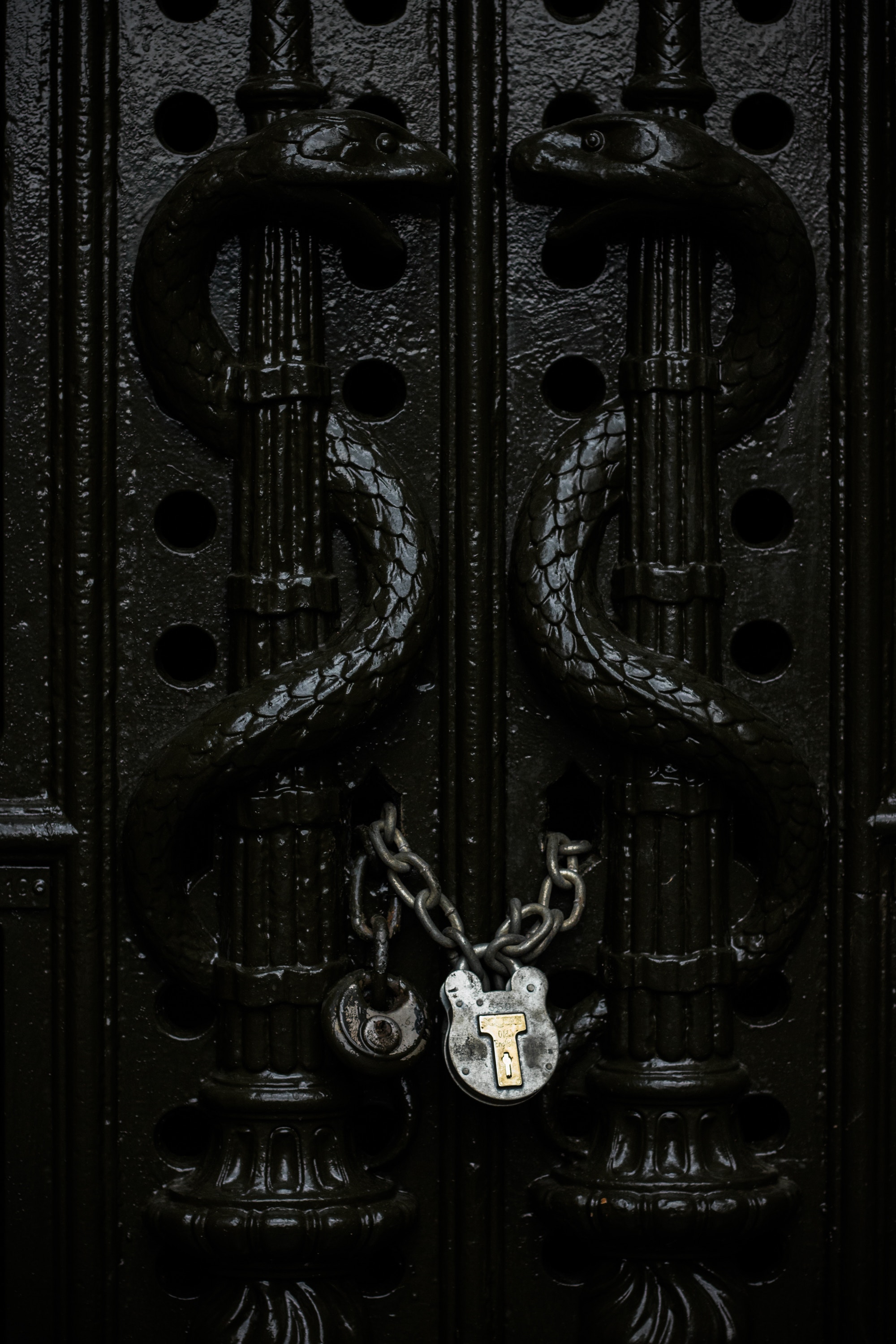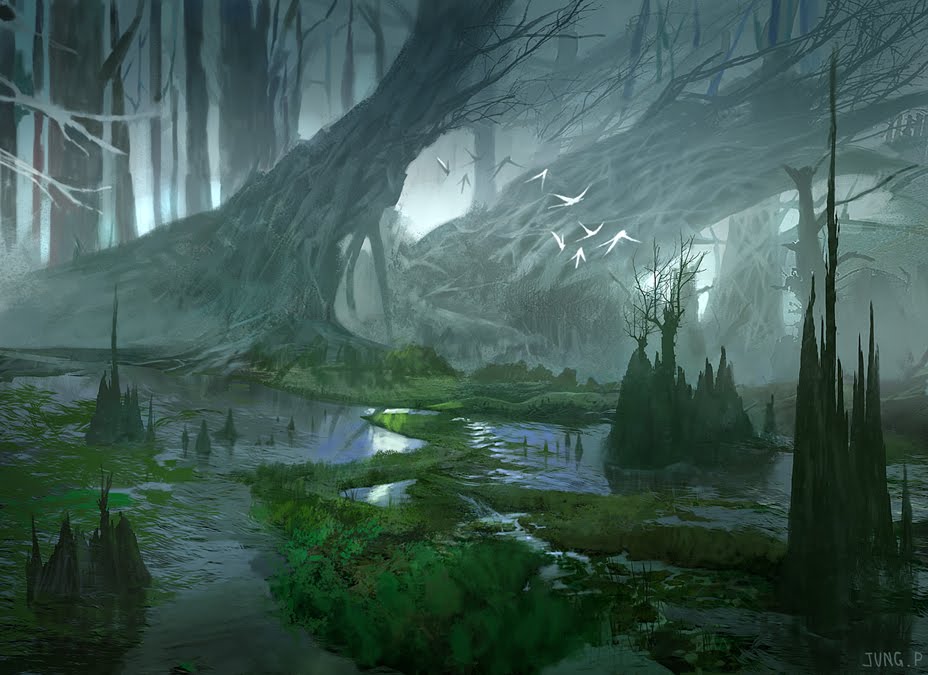As always, you can find links to the entire series here.
Another quick note: Life Has Intervened, and while I’d still like to do collaborative blog posts with my other three players, they’re going to have to wait until things get a little less crazy.
Coiled Among the Rocks
The last time I detailed a Grim City, it was Alchova, one of the worst of them. (Possibly even the worst – it’s real bad.) But sometimes the rule of Evil isn’t quite as in-your-face as Alchova is.
Klagaron Lach Dalan G’Nor (Citadel of the Serpent’s Stone) used to simply be known as The Outer Wall – it is a surface community of dwarves that has grown up around an ancient fortified surface trading post, and the name “The Outer Wall” was intended to be more than a little tongue-in-cheek, as the rest of the city it was attached to was a traditional underground dwarven mine city. Life was fairly normal until a routine cavern expansion (the dwarves were in the process of expanding a university of theirs) broke into a nest of something terrible. Unknown to the dwarves, a malignant ecosystem of subterranean, mind-controlling plants and fungi had infected a hive of Kruthik (see Mordenkainen’s Tome of Foes) and the resulting infected hive had inhabited a series of large, open caves near the the dwarves. The result was predictably bad. The initial work crew immediately inhaled a cloud of spores which overcame them as the fungally-dominated Kruthik swarmed past. Without an early warning, the casualties were horrific and before any sort of defense was mounted, the initial breach area was overrun and basically unassailable. The dwarves, being dwarves, fought valiantly, but the swarming menace seemed endless and their own fallen sometimes stood up as horrible fungal zombies. As they were pushed out of more and more territory by the seething horde, they grew more desperate and in their desperation, turned to mercenary companies.
One such mercenary company was the Hand of Shattered Stone. Led by a group of hardened medusas and their chained basilisks, the primarily human and naga mercenary company was hardened and ruthless, but they got the job done. They made significant headway against the swarming fungal menace by attacking them in a way that neutralized their fungal spores: petrification. They even managed to turn the swarm’s tactics against it to a limited extent by turning petrified kruthiks into Stone Cursed and sending them back against their fellows. The desperate circumstances and shared focus on stone overcame what would have normally been deep concerns about the mercenaries and the dwarves were able to evacuate most of their remaining civilians to the surface trading post. The swarm was seemingly endless, however, and after over two years of savage fighting the decision was made to collapse the mountain. A group of dwarves led by the king and his honor guard went into the city with the leadership of the Hand of Shattered Stone. Though the mission was successful with the mountain collapsing on the horde and sealing them off once again, only the mercenaries returned.
The collapsing of the mountain had another unfortunate effect: it cut off the only access road the city had enjoyed, and the massive rising cloud sent the signal for many miles around that “something horrible has happened here.” The city’s remnants and the mercenaries were safe, but they were cut off. Over the course of the next several years, a series of circumstances eliminated all of the rightful successors to the throne. One of the king’s sons died in battle. Another went crazy with “surface sickness” and was institutionalized, and the third was convicted of a series of horrible crimes and banished. The mercenaries “temporarily” assumed control of the city until “a suitable new king could be found,” but shortly thereafter , the infested kruthik broke free at the base of the mountain and assaulted the city again. While the incursion was smaller and more easily contained (they had walls between them and the enemy this time) the constant fighting left little time for matter of succession. In the time since then, the mercenaries have gradually assumed control of most aspects of the society, and their naga and human members have integrated with the dwarves. The society has never recovered from its siege mentality, however, and the military (which is now a blend of the old dwarven forces and those of the former mercenary company) gets the best of everything with the rest of society subsisting on rations.
That was about 150 years ago. In the intervening years, technology has advanced, the old walled trading post has been expanded into a massive walled city with a huge citadel overlooking it, and the medusas are still in charge. The siege mentality has not lifted, either. Patrols still walk the walls, the military still gets the best of everything, and the rest of the city makes do. In recent years, talk has turned to “reclaiming the ancestral halls” and the citadel has started experimenting with armored vehicles and gas masks to avoid the spores.
Morality
Pride/Humility: Indulger (-1) – There’s definitely a “we know best” attitude among the medusas.
Envy/Kindness: Monster (-2) – The leadership of the citadel seems to look at everything in the city with an attitude of “why doesn’t the military have this?” There’s also an extreme distrust of outsiders. People not from the city have no rights and are often subject to horrible treatment.
Wrath/Patience: Indulger (-1) – The city is extremely militaristic, and martial law is harsh.
Sloth/Diligence: Seeker (+1) – Even the ruling class is invested in the safety of everyone (who behaves) inside the walls. People tend to work hard.
Greed/Charity: Indulger (-1) – The population is given the necessities and just enough beyond that not to openly revolt. Luxuries are rare and concentrated more densely in the military, but even there they aren’t common.
Gluttony/Temperance: Seeker (+1) – There is a strong culture of efficiency and thrift and people see being responsible with resources as helping their society.
Lust/Chastity: Monster (-2) – The Citadel practices chattel slavery, and because of it, horrible abuses happen. With respect to my own personal lines and veils, that’s about as much as I feel like putting in the setting.
Overall Virtue Score: -5 (Evil) While not the over-the-top, crushing, all-encompassing evil of Alchova, The Citadel of the Serpent’s Stone is still not a place many people would choose to live.
Personality
Duty/Independence: Exemplar: Duty (+2) – The siege mentality pervades every aspect of life. People work grueling hours to prop up the military and don’t get much in return.
Efficiency/Artistry: Exemplar: Efficiency (+2) – Klagaron Lach Dalan G’Nor has basically become a massive military base. Everything is designed for maximum function and no thought is given to beauty.
Meticulousness/Expediency: Indifferent (0) – A careful balance is struck and maintained; both are valued, neither is neglected.
Satisfaction/Excitement: Favorer: Satisfaction (+1) – “Did you make it from sunrise to sundown alive? Yes? Then you had a good day.” -popular saying in Klagaron Lach Dalan G’Nor.
Sacrifice/Pragmatism: Exemplar: Sacrifice (+2) – Everyone and everything is expendable (even the leadership, or so they insist) in service of keeping the citadel safe.
Overall Personality Score: +7 (Lawful) – Klagaron Lach Dalan G’Nor is a place of heavy discipline and regimented living, all in the name of security.
Hard and Stoic
Klagaron Lach Dalan G’Nor is a place where things are evaluated on their necessity and utility. Art of any kind is usually seen as wasteful (though isn’t banned outright and simple serpent designs are common). Seasonings are not used in food with nearly the frequency they are in other places. Buildings receive windows with an eye to security (which means lower floors have smaller windows to deny alternate means of entry and upper floors have larger ones to better survey the surrounding area). However, the leadership of The Citadel realizes that its living being aren’t robots and makes some modest concessions to aesthetics, comfort, and so on realizing that if they make daily life too hard, the entire society could collapse. This is typically done at the expense of outsiders and prisoners who are treated as resources rather than people.
Crime and punishment are harsh – military discipline is applied to everyone, even the very old and very young, the death penalty is common (though not as common or as sadistically applied as it is in Alchova), and the most common form of it is petrification, after which point the executed party’s “statue” is turned into building materials. Slavery is another common punishment and slaves are not treated well at all.
Perhaps unexpectedly, there is very little direct infernal influence in The Citadel. A few fiendish bargains have been made (though not by the medusas – yet, anyway) and there are a few clerics of The Adversary around, but you won’t see a bone devil while walking down the street. Additionally, the ruthless, paranoid authorities seem to be fairly above-board and honest, if terribly harsh. There isn’t a lot of double standarding, summary punishment, and cruel dominance behavior evident. What there is in its place is absolute callous indifference. You obey the rules and do what’s expected of you, or you either wind up as a slave or as bricks. The medusas weren’t nice people to begin with, and neither were the mercenaries, but as everyone involved saw it, they did the best they could in a terrible situation.
Well, except for the nagging matter of the royal family.
In truth, I haven’t decided exactly how scheming I’m going to make the medusas in the game – the loss of the king could have been them acting intentionally or a tragedy. The king’s sons likewise could have been machinations or simple misfortune. If you decide to run a game in this setting, that answer is absolutely up to you.
What I have decided is that the fungus-infested underground horde is a legitimate, independent threat. No parties involved in the history of Klagaron Lach Dalan G’Nor were involved in the creation of those monsters. Sometimes fantasy words just have terrifying things lurking in their corners, though they could have been something one of The Adversary’s captains came up with back in antiquity.
Notable Groups and Individuals
The Sisters of Shattered Stone: The city’s governing body is the group of eight medusas that ran the Hand of Shattered Stone mercenary company. Normally medusas are not very physically-powerful, but these ones are the exception. Built more like this Wonder Woman cosplayer than the art in the monster manual, they wear armor and carry heavy, smashing mauls with them – they will often petrify enemies and then smash the statue to prevent the enemy from being returned to their normal form. (And they work well as a team.) They are harsh, but by all appearances, they do actually try to be consistent in their judgments, not showing obvious favoritism and punishing even the highly-placed as harshly as the lowly. None of this diminishes the fact that they have gone around the lines of succession and set themselves up as absolute military oligarchs, however.
The Great Snake: The Hand of Shattered Stone has a number of serpentine monsters that it used as shock troops or living siege engines. One of the most imposing is a massive, scarred constrictor snake that stretches about 85 feet long and weighs just north of 3 tons. Through some sort of magic, it’s gained human-level intelligence and it can speak, though it rarely chooses to do so. These days it mostly goes out on exterior patrols, subsisting on mountain goats and the occasional wandering monster or prisoner who gets out of line. (It’s a Titanboa from Tome of Beasts with a boosted intelligence score.)
The Citadel Engineering Corps: A hardened unit of combat engineers (almost all dwarves) with heavy shotguns, massive armored vehicles, and gas masks, the Engineering Corps has the daunting job of going into the collapsed mountain and trying to recover what they can. The biggest prize would be the remains of the king and his honor guard, but valuable materials, tools, and writings (many of which were on metal plates and could be rendered readable again with mending spells) are also highly sought-after. They will occasionally run into a pocket of the fungal horde and have the means to fight them without joining their ranks.
The Trade Corps: The trade corps exist to bridge the gap between a prevailing attitude of severe, paranoid xenophobia and the very real need for things not found in the territory controlled by Klagaron Lach Dalan G’Nor. They are a serious bunch, and anything they trade for is inspected to an insulting degree before being sent back to the city, but their prices are fair (if generally inflexible) and they can be counted on to hold up their end of a bargain. Failure to do so on the other side of a transaction is likely to involve violence, however, and they have a pitiless group of killers as part of their organizational unit.
Berodic Daganal: The “insane” son of the old king has been quietly amassing allies from his confinement and seems to be planning something, but strangely, it doesn’t seem to be a reclamation of the throne. Due to some ancient laws that are still on the books an honored by the medusas, he is able to send and receive sealed correspondence, and most of what he’s been sending and receiving seems to be concentrated in Laraloch-Thistivuel.
Aynwal Dagnal: The other surviving royal heir was exiled over a century ago and his whereabouts are unknown, though some long-term governmental staffers occasionally report seeing envelopes for his brother written in what looks like his handwriting. Aynwal was a poet and a lover of nature and spent an inordinate amount of time on the surface for a dwarf, even before the invasion happened. His exile came as a shock to many.
Notable Locations
The Dark Road: The Dark Road is the name the Citadel Engineering Corps have given to the tunnel into the collapsed ruins of the old dwarven city from which The Citadel sprang. It is a massive, fortified, reinforced tunnel full of fallback points, heavy gates, remotely-triggered traps and several planned cave-in spots already rigged with explosives in case it needs to be collapsed again. The entire tunnel is lit with both electrical and magical light sources and is astoundingly bright, especially given the name.
Scalagan’s Perch: A newly-constructed watch post high up on the side of the collapsed mountain, Scalagan’s Perch is an ever-open eye from on high that stares down at the city and its surrounding environs alike. It’s only reachable via a long, long staircase or by the air, and most of the traffic up and down is on wyvern-back. There is a military wyvern breeding facility at the site, and wyverns of various ages can be found there being trained as mounts for the military.




